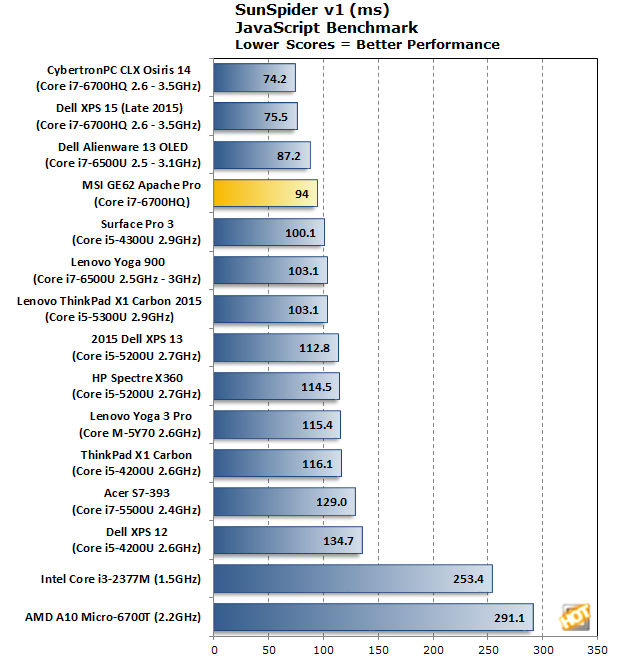The Apache Pro is primarily focused on gaming, though any laptop that has the muscle for today’s PC games should also be a competent performer in other areas, such as ordinary content creation, web, and productivity chores. With that in mind, we kicked off our testing with the ATTO Disk Benchmark, SunSpider, Cinebench and PCMark 8 before diving into the graphics tests.
 |
ATTO Disk Benchmark
|
Peak Sequential Storage Throughput
|
|
The ATTO Disk Benchmark gives us a look at the Apache Pro's SSD performance. MSI stocked our test system with a 256GB M.2 SATA 6Gbps SSD.
Oh MSI, why must you be such a tease! Both the box the Apache Pro ships in and the sticker that's plastered on the system's wrist rest talk up the awesome speed benefits of an M.2 SSD with a PCIe Gen3 x4 interface. Unfortunately, that's not what this particular Apache Pro ships with. The SSD is indeed an M.2 drive, but it hitches a ride on the SATA 6Gbps bus. As such, its read performance topped out at around 564MB/s in ATTO while write performance hit a high of 339MB/s. That's respectable and still leaps and bounds ahead of a mechanical hard drive, but it's not in the same class (or ZIP code) as a PCIe-based SSD.
Outside of running benchmarks, the SSD is mostly snappy. Navigating Windows is usually smooth and programs load fast, though we did notice the occasional lag while zipping around the OS.
 |
Sunspider Javascript Benchmark
|
Javascript Processing Performance
|
|
Next up, we have some numbers from the SunSpider JavaScript benchmark. According to the SunSpider website:
This benchmark tests the core JavaScript language only, not the DOM or other browser APIs. It is designed to compare different versions of the same browser, and different browsers to each other. Unlike many widely available JavaScript benchmarks, this test is real-world, balanced and statistically sound.
We should note that this is more of a platform test, in that different browser versions, associated with different OS types can and do affect scores. However, among the Windows 10 powered machines here, all things are relatively equal.
The Apache Pro took fourth place in SunSpider and was one of just four systems to dip below the 100ms mark. Looking at the other results, you can see how performance has improved here over time. SunSpider is far from the end-all-be-all of benchmarks, though as indicated by the Apache Pro's score, surfing the web is made fast and easy here.
 |
Cinebench R11.5
|
3D Rendering On The CPU And GPU
|
|
This is a multi-threaded, multi-processor aware benchmark that renders a photorealistic 3D. This scene makes use of various algorithms to stress all available processor cores. The rate at which each test system was able to render the entire scene is represented in the graph below.
Here the Apache Pro took a second place finish with an OpenGL score of 64.66 frames per second. That was enough to creep ahead of the Asus ROG system, but not the CybertronPC laptop, both of which are wielding a GeForce GTX 970M GPU based on Maxwell. This was the only time we saw the GTX 1060 hang around the GTX 970M rather than stay several paces ahead.









